Get free scan and check if your device is infected.
Remove it nowTo use full-featured product, you have to purchase a license for Combo Cleaner. Seven days free trial available. Combo Cleaner is owned and operated by RCS LT, the parent company of PCRisk.com.
What is Bank Of America Email Virus?
"Bank Of America Email Virus" is another spam email campaign that proliferates the Emotet trojan. Developers send thousands of emails claiming that users' money transactions are delayed and asking them to confirm transactions in attached MS Word documents. This is a scam - the opened documents infect systems with the Emotet trojan.
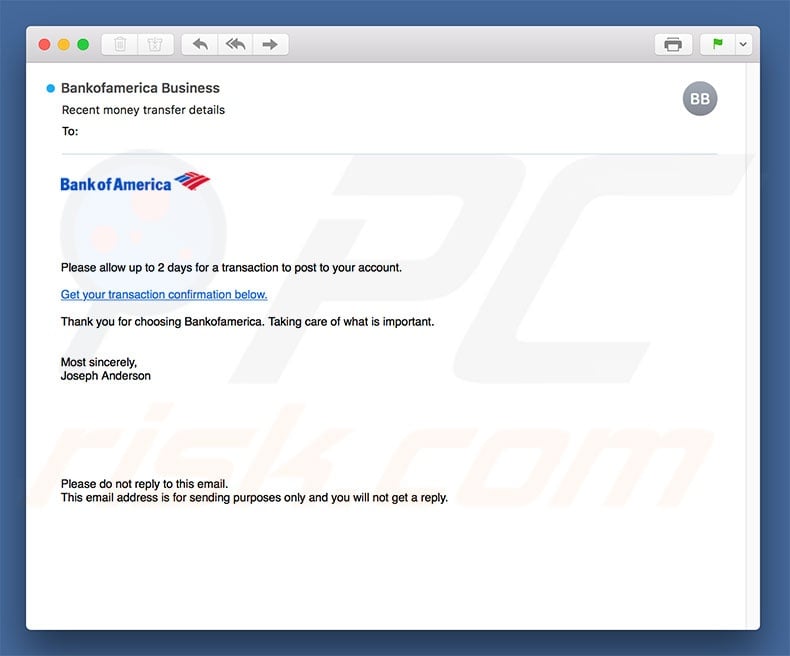
Cyber criminals claim to be employees of Bank of America and ask users to confirm money transactions to trick them into opening malicious attachments. This behavior is very common amongst cyber criminals. They often register email addresses and web domains by including names of legitimate companies and governmental agencies.
This is done to give the impression of legitimacy - it is much simpler to trick users into opening files received from familiar names. Emotet records various sensitive information, including saved logins/passwords and browsing activity.
Cyber criminals might then gain access to social networks, banks, and other personal accounts - misusing them to generate revenue (through money transfers, online purchases, identity theft, etc.) Therefore, the presence of high-risk trojan such as this can lead to serious privacy issues and significant financial loss.
If you have recently opened "Bank Of America Email Virus" attachments, there is a high probability that your system is infected. Therefore, scan it with a reputable anti-virus/anti-spyware suite and eliminate all threats.
| Name | Bank Of America spam |
| Threat Type | Trojan, Password stealing virus, Banking malware, Spyware |
| Symptoms | Trojans are designed to stealthily infiltrate victim's computer and remain silent thus no particular symptoms are clearly visible on an infected machine. |
| Distribution methods | Infected email attachments, malicious online advertisements, social engineering, software cracks. |
| Damage | Stolen banking information, passwords, identity theft, victim's computer added to a botnet. |
| Malware Removal (Windows) |
To eliminate possible malware infections, scan your computer with legitimate antivirus software. Our security researchers recommend using Combo Cleaner. Download Combo CleanerTo use full-featured product, you have to purchase a license for Combo Cleaner. 7 days free trial available. Combo Cleaner is owned and operated by RCS LT, the parent company of PCRisk.com. |
There are many trojan-type viruses that share similarities with Emotet. The list of examples includes (but is not limited to) LokiBot, TrickBot, FormBook, and Pony.
Most are distributed using spam emails. The behavior of these viruses barely differs - in most cases, trojans collect various personal information. In some cases, however, they proliferate other malware (typically ransomware). In any case, trojans such as Emotet pose an extreme threat to your privacy and computer safety.
How did Bank Of America Email Virus infect my computer?
As mentioned, "Bank Of America Email Virus" distributes a malicious MS Word attachment. After opening this file, users are immediately asked to enable macro commands. Once macros are enabled, the document executes commands that download and install malware.
Although this malware distribution method is quite simple, it has a major flaw - the document is unable to infect the system if the user opens it with an application other than MS Word (malware will not be downloaded). Furthermore, Emotet targets the Microsoft Windows Operating System only and, therefore, other platforms are safe.
How to avoid installation of malware?
Lack of knowledge and careless behavior are the main reasons for computer infections. The key to safety is caution. Therefore, pay close attention when browsing the Internet. Think twice before opening email attachments. Files that seem irrelevant or have been received from suspicious/unrecognizable email addresses should never be opened.
Furthermore, have a reputable anti-virus/anti-spyware suite installed and running. Note that more recent versions of MS Office (2010 and above) open newly-downloaded documents in "Protected View" mode. This prevents malicious attachments from downloading and installing malware.
Therefore, using older versions is not recommended. If you have already opened "Bank Of America Email Virus" attachment, we recommend running a scan with Combo Cleaner Antivirus for Windows to automatically eliminate infiltrated malware.
Text presented in the "Bank Of America Email Virus" email message:
Subject: Recent money transfer details
Please allow up to 2 days for a transaction to post to your account.
Get your transaction confirmation below.
Thank you for choosing Bankofamerica. Taking care of what is important.
Most sincerely,
Joseph Anderson
Please do not reply to this email.
This email address is for sending purposes only and you will not get a reply.
Malicious attachment distributed via "Bank Of America Email Virus" spam campaign:
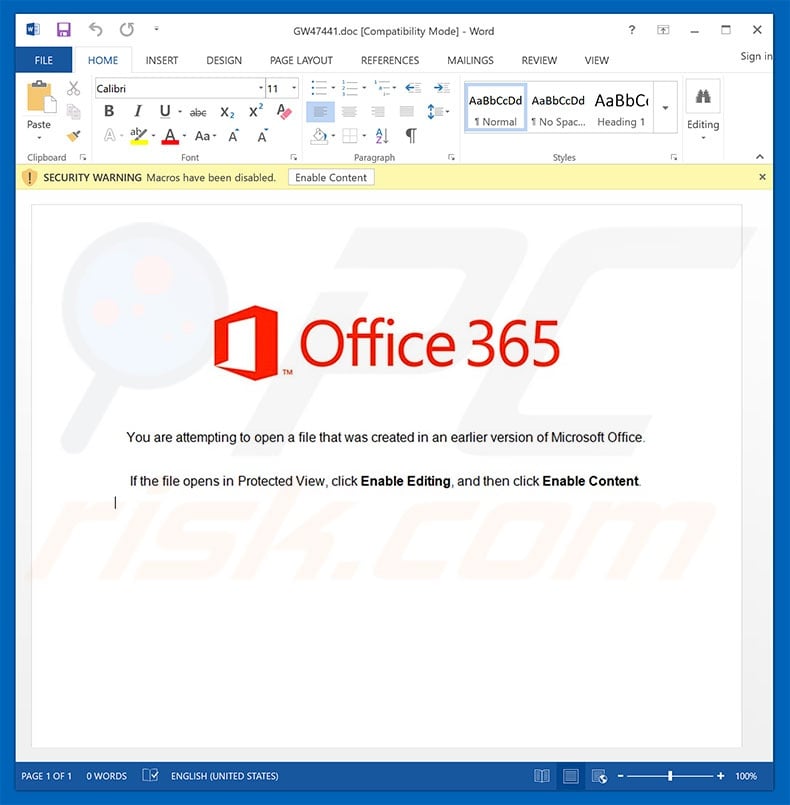
Another variant of fake Bank of America email spreading malware:
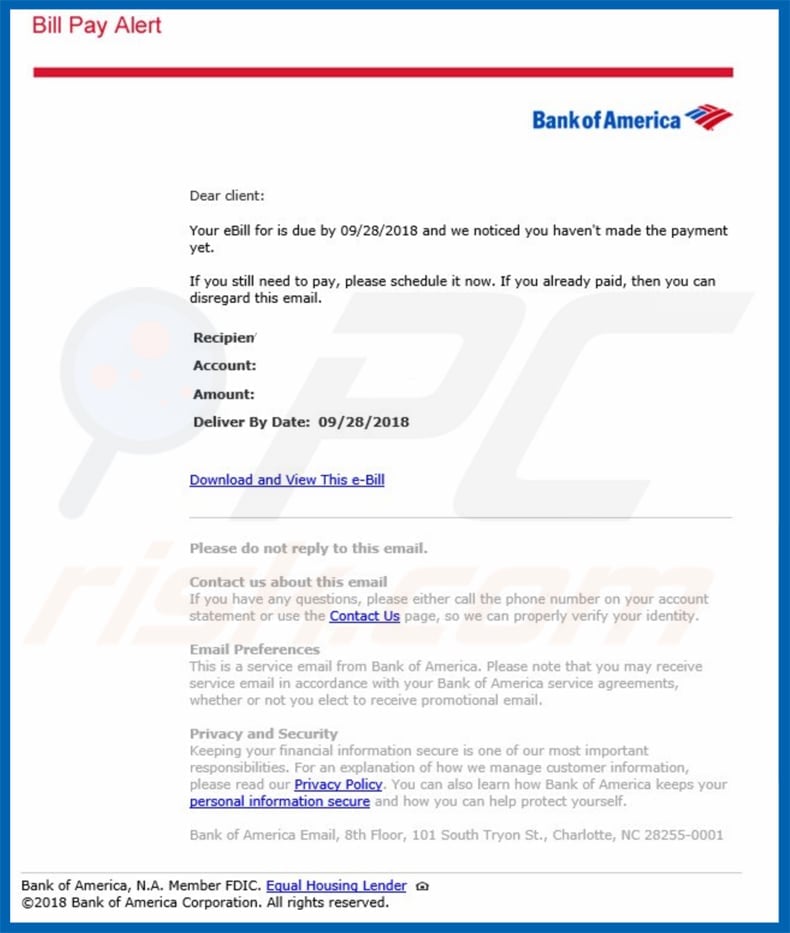
Text in this variant:
Subject: Bill Pay Alert
Dear client, Your eBill for is due by - and we noticed you haven't made the payment yet. If you still need to pay, please schedule it now. If you already paid, then you can disregard this email.
Another variant of "Bank Of America" spam campaign's email, which also proliferates Emotet trojan. The malicious attachment is a Microsoft Excel file:
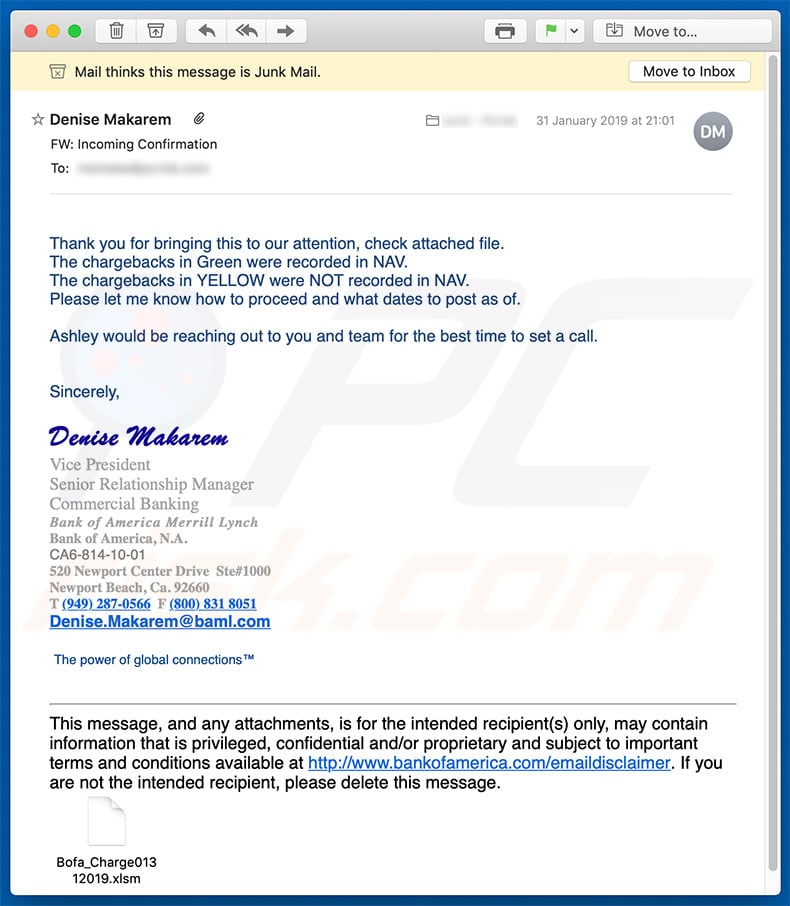
Text presented within this email:
Subject: FW: Incoming Confirmation
Thank you for bringing this to our attention, check attached file.
The chargebacks in Green were recorded in NAV.
The chargebacks in YELLOW were NOT recorded in NAV.
Please let me know how to proceed and what dates to post as of.Ashley would be reaching out to you and team for the best time to set a call.
Sincerely,
Denise Makarem
Vice President
Senior Relationship Manager
Commercial Banking
Bank of America Merrill Lynch
Bank of America, N.A.
CA6-814-10-01
520 Newport Center Drive Ste#1000
Newport Beach, Ca. 92660
T (949) 287-0566 F (800) 831 8051
Denise.Makarem@baml.com
The power of global connections
This message, and any attachments, is for the intended recipient(s) only, may contain information that is privileged, confidential and/or proprietary and subject to important terms and conditions available at hxxp://www.bankofamerica.com/emaildisclaimer. If you are not the intended recipient, please delete this message.
Screenshot of the malicious attachment:
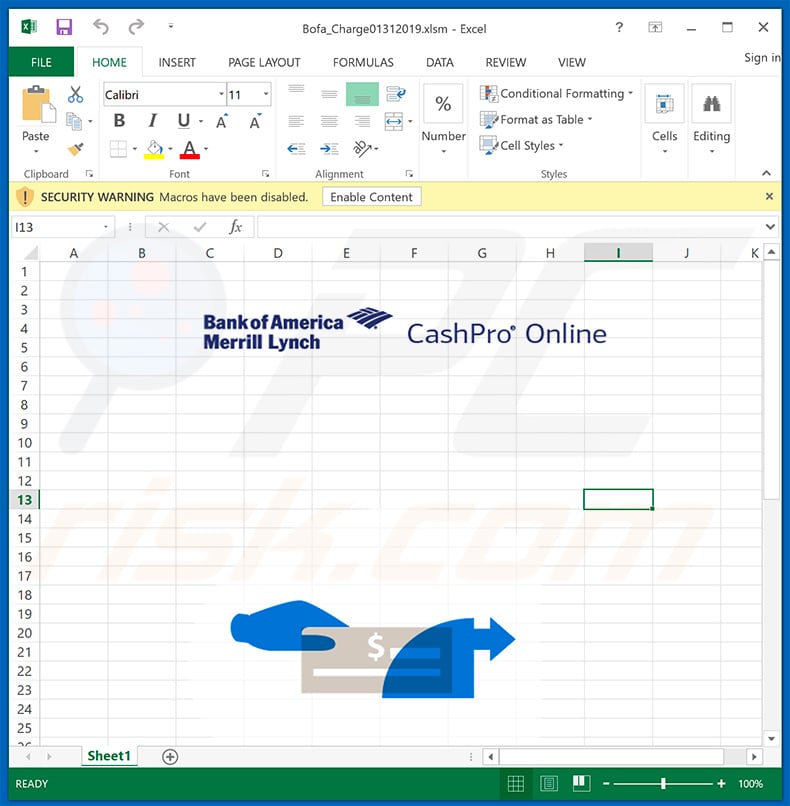
A phishing email that uses Bank Of America name to steal user names and passwords:
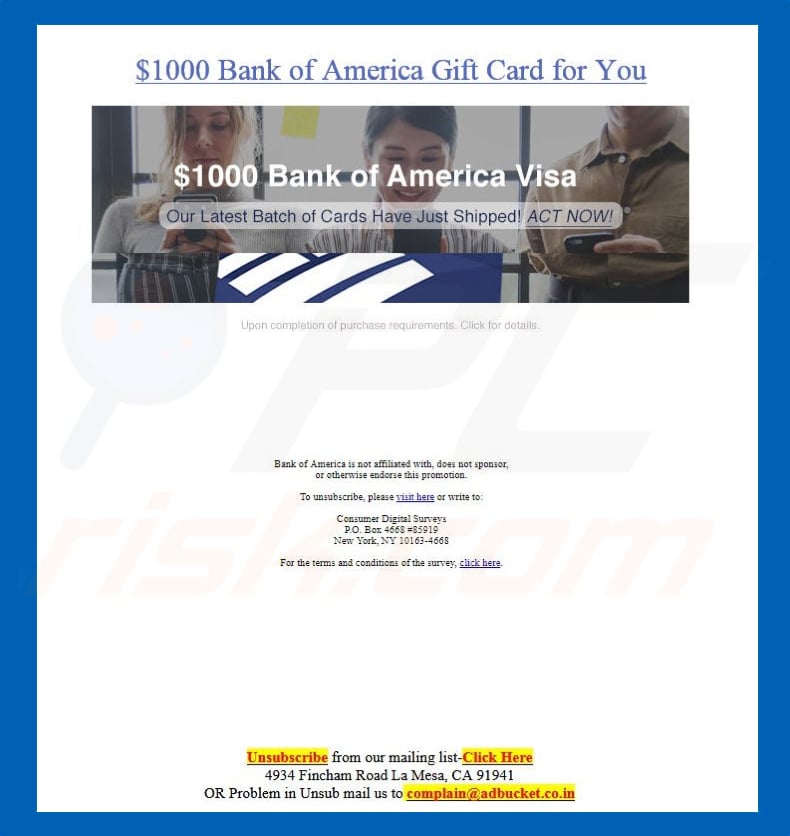
Text in this phishing attempt:
$1000 Bank of America Gift Card for You
$1000 Bank of America Visa
Our Latest Batch of Cards Have Just Shipped! ACT NOW!
Bank of America is not affiliates with, does not sponsor, or otherwise endorse this promotion. To unsubscribe, please visit here or write to: Consumer Digital Surveys P.O. Box 4668#85919 New York, NY 10163-4668
Screenshot of a fake Bank Of America website promoted via spam emails:
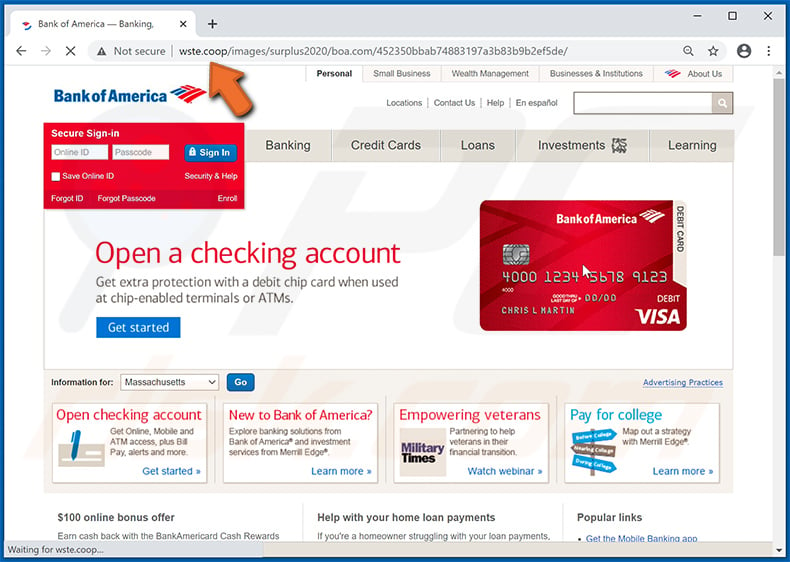
Screenshot of the second page displayed after entering login and password:
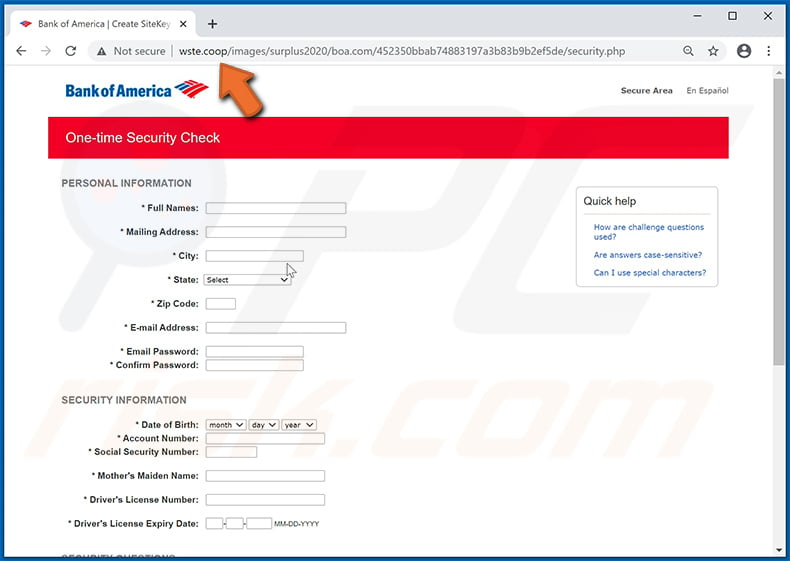
Another example of Bank of America-themed spam email used to promote a phishing website:
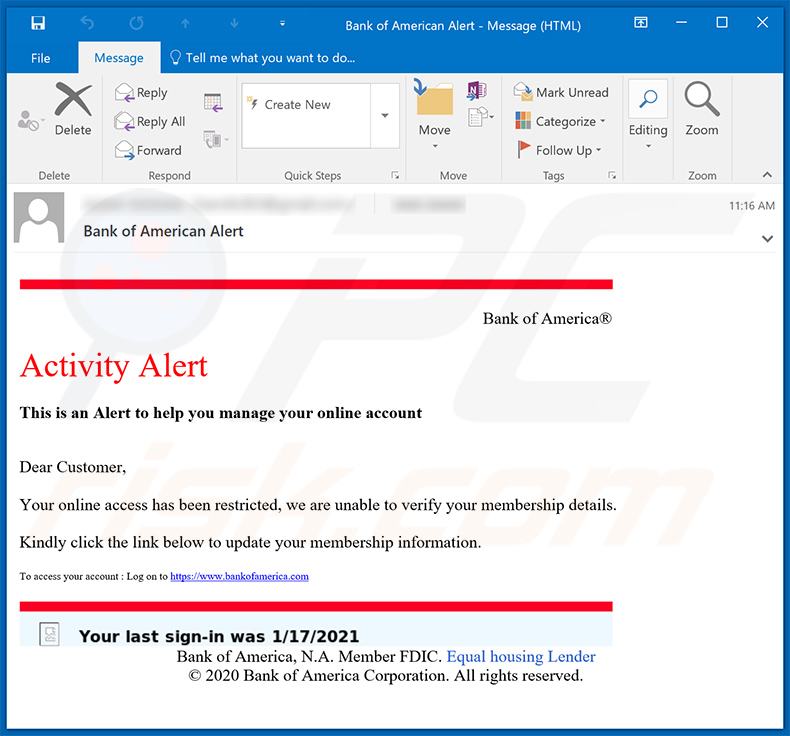
Text presented within:
Subject: Bank of American Alert
Bank of America®
Activity Alert
This is an Alert to help you manage your online account
Dear Customer,Your online access has been restricted, we are unable to verify your membership details.
Kindly click the link below to update your membership information.
To access your account : Log on to hxxps://www.bankofamerica.com
Bank of America, N.A. Member FDIC. Equal housing Lender
© 2020 Bank of America Corporation. All rights reserved.
Instant automatic malware removal:
Manual threat removal might be a lengthy and complicated process that requires advanced IT skills. Combo Cleaner is a professional automatic malware removal tool that is recommended to get rid of malware. Download it by clicking the button below:
DOWNLOAD Combo CleanerBy downloading any software listed on this website you agree to our Privacy Policy and Terms of Use. To use full-featured product, you have to purchase a license for Combo Cleaner. 7 days free trial available. Combo Cleaner is owned and operated by RCS LT, the parent company of PCRisk.com.
Quick menu:
- What is Bank Of America spam?
- Types of malicious emails.
- How to spot a malicious email?
- What to do if you fell for an email scam?
Types of malicious emails:
![]() Phishing Emails
Phishing Emails
Most commonly, cybercriminals use deceptive emails to trick Internet users into giving away their sensitive private information, for example, login information for various online services, email accounts, or online banking information.
Such attacks are called phishing. In a phishing attack, cybercriminals usually send an email message with some popular service logo (for example, Microsoft, DHL, Amazon, Netflix), create urgency (wrong shipping address, expired password, etc.), and place a link which they hope their potential victims will click on.
After clicking the link presented in such email message, victims are redirected to a fake website that looks identical or extremely similar to the original one. Victims are then asked to enter their password, credit card details, or some other information that gets stolen by cybercriminals.
![]() Emails with Malicious Attachments
Emails with Malicious Attachments
Another popular attack vector is email spam with malicious attachments that infect users' computers with malware. Malicious attachments usually carry trojans that are capable of stealing passwords, banking information, and other sensitive information.
In such attacks, cybercriminals' main goal is to trick their potential victims into opening an infected email attachment. To achieve this goal, email messages usually talk about recently received invoices, faxes, or voice messages.
If a potential victim falls for the lure and opens the attachment, their computers get infected, and cybercriminals can collect a lot of sensitive information.
While it's a more complicated method to steal personal information (spam filters and antivirus programs usually detect such attempts), if successful, cybercriminals can get a much wider array of data and can collect information for a long period of time.
![]() Sextortion Emails
Sextortion Emails
This is a type of phishing. In this case, users receive an email claiming that a cybercriminal could access the webcam of the potential victim and has a video recording of one's masturbation.
To get rid of the video, victims are asked to pay a ransom (usually using Bitcoin or another cryptocurrency). Nevertheless, all of these claims are false - users who receive such emails should ignore and delete them.
How to spot a malicious email?
While cyber criminals try to make their lure emails look trustworthy, here are some things that you should look for when trying to spot a phishing email:
- Check the sender's ("from") email address: Hover your mouse over the "from" address and check if it's legitimate. For example, if you received an email from Microsoft, be sure to check if the email address is @microsoft.com and not something suspicious like @m1crosoft.com, @microsfot.com, @account-security-noreply.com, etc.
- Check for generic greetings: If the greeting in the email is "Dear user", "Dear @youremail.com", "Dear valued customer", this should raise suspiciousness. Most commonly, companies call you by your name. Lack of this information could signal a phishing attempt.
- Check the links in the email: Hover your mouse over the link presented in the email, if the link that appears seems suspicious, don't click it. For example, if you received an email from Microsoft and the link in the email shows that it will go to firebasestorage.googleapis.com/v0... you shouldn't trust it. It's best not to click any links in the emails but to visit the company website that sent you the email in the first place.
- Don't blindly trust email attachments: Most commonly, legitimate companies will ask you to log in to their website and to view any documents there; if you received an email with an attachment, it's a good idea to scan it with an antivirus application. Infected email attachments are a common attack vector used by cybercriminals.
To minimise the risk of opening phishing and malicious emails we recommend using Combo Cleaner Antivirus for Windows.
Example of a spam email:

What to do if you fell for an email scam?
- If you clicked on a link in a phishing email and entered your password - be sure to change your password as soon as possible. Usually, cybercriminals collect stolen credentials and then sell them to other groups that use them for malicious purposes. If you change your password in a timely manner, there's a chance that criminals won't have enough time to do any damage.
- If you entered your credit card information - contact your bank as soon as possible and explain the situation. There's a good chance that you will need to cancel your compromised credit card and get a new one.
- If you see any signs of identity theft - you should immediately contact the Federal Trade Commission. This institution will collect information about your situation and create a personal recovery plan.
- If you opened a malicious attachment - your computer is probably infected, you should scan it with a reputable antivirus application. For this purpose, we recommend using Combo Cleaner Antivirus for Windows.
- Help other Internet users - report phishing emails to Anti-Phishing Working Group, FBI’s Internet Crime Complaint Center, National Fraud Information Center and U.S. Department of Justice.
Share:

Tomas Meskauskas
Expert security researcher, professional malware analyst
I am passionate about computer security and technology. I have an experience of over 10 years working in various companies related to computer technical issue solving and Internet security. I have been working as an author and editor for pcrisk.com since 2010. Follow me on Twitter and LinkedIn to stay informed about the latest online security threats.
PCrisk security portal is brought by a company RCS LT.
Joined forces of security researchers help educate computer users about the latest online security threats. More information about the company RCS LT.
Our malware removal guides are free. However, if you want to support us you can send us a donation.
DonatePCrisk security portal is brought by a company RCS LT.
Joined forces of security researchers help educate computer users about the latest online security threats. More information about the company RCS LT.
Our malware removal guides are free. However, if you want to support us you can send us a donation.
Donate
▼ Show Discussion